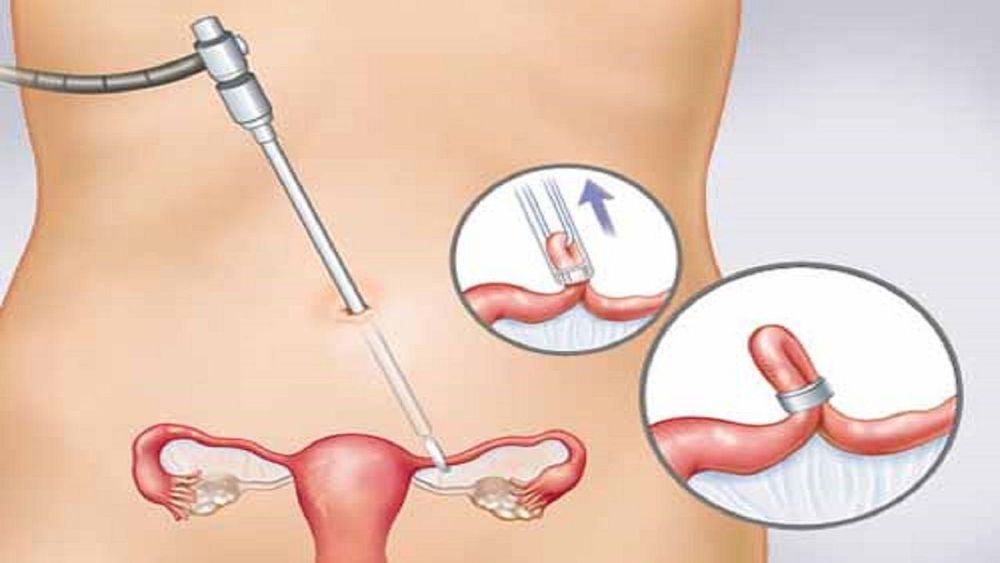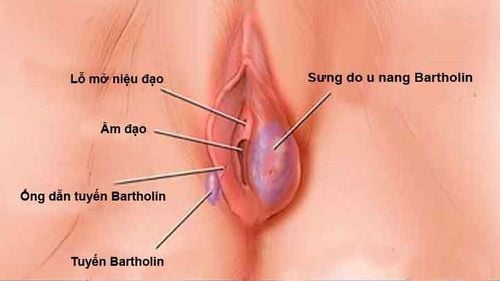This is an automatically translated article.
Female sterilization, also known as tubal ligation, is a permanent method of birth control performed by blocking the fallopian tubes, preventing the egg from reaching the sperm for fertilization. This is a safe, highly effective method that does not affect health as well as sex.
1. What is tubal ligation?
Tubal ligation or tubal ligation is a method of birth control that is performed by cutting or sealing the fallopian tubes, preventing the egg from reaching the sperm for fertilization. Tubal ligation is an effective method of permanent contraception (over 99%) and does not affect health and sexual desire.
Tubal ligation surgery is not the cause of weight gain, facial hair growth and does not detract from femininity. Besides, this method only works to prevent pregnancy and is not effective in preventing sexually transmitted diseases. Therefore, you need to combine other methods of birth control such as using condoms to prevent in case of sexually transmitted diseases.
2. In what cases is tubal ligation indicated?
According to recommendations from doctors, sterilization procedure in women by tubal ligation is usually indicated in the following cases:
Women of childbearing age have had enough desired number of children, have the need to use a permanent method of contraception and does not reverse after full consultation with a doctor. Women with diseases, if pregnant, will be dangerous. In addition, this procedure should also be performed with caution when a woman has the following characteristics:
Cases with gynecological diseases such as breast cancer, uterine fibroids, a history of pelvic inflammatory disease from the past previous pregnancy, history of pelvic or lower abdominal surgery. Patients with cardiovascular disease such as high blood pressure, uncomplicated heart disease or a history of stroke. Patients with chronic diseases such as epilepsy, compensated cirrhosis, hypothyroidism, liver tumors or liver schistomomiasis, moderate iron deficiency anemia, kidney disease, etc. Doctors need to postpone sterilization procedures in cases of women with the following conditions:
Post-pregnancy period with pre-eclampsia or eclampsia. Women who are pregnant or during 7 - 42 days postpartum. People with serious postpartum complications such as infection, bleeding or trauma, uterine blood stasis, vaginal bleeding. Patients with lung disease such as pneumonia, bronchitis, severe iron deficiency anemia (hemoglobin < 7 g/Dl).

Thủ thuật thắt ống dẫn trứng được thực hiện với những phụ nữ có nhu cầu sử dụng biện pháp tránh thai vĩnh viễn và không phục hồi
3. Is tubal ligation sterilization painful?
Many patients have asked the question "Is female sterilization surgery painful?" and was answered as follows.
The doctor anesthetizes the patient before performing tubal ligation surgery. Methods of anesthesia include general anesthesia, regional anesthesia, local anesthesia, and intravenous sedation. Based on your medical condition and the method of tubal ligation, the doctor will choose the appropriate anesthesia technique. So, after the anesthetic technique, you will only feel discomfort but no pain during the tubal ligation surgery.
4. When is the tubal ligation procedure performed?
In non-pregnant women, tubal ligation is best performed after the menstrual period has ended, which will help rule out the procedure on a pregnant woman.
In pregnant women, tubal ligation is best performed during a cesarean section or in the postpartum period. Doctors perform the procedure in the postpartum period preferably between 24 - 36 hours after giving birth to reduce the risk of bleeding and the mother can rest after delivery. In case the mother breaks water early, has a fever during labor and there is a risk of infection, the doctor should suspend the procedure, possibly moving to the 8th week postpartum.
5. Is it possible to reconnect the fallopian tubes after sterilization?
According to recommendations from doctors, resumption of the fallopian tubes after sterilization is a complicated procedure, with a low success rate and high cost. Besides, even if tubal junction surgery has been performed successfully, the pregnancy rate is not high.
6. How is tubal ligation performed?
Sterilization procedures in women are performed by doctors according to the following methods:
Laparoscopy: Considered the traditional method to perform sterilization and is usually performed in the 6th week after born with general anesthesia. Laparoscopy: In this method, the doctor seals the openings of the fallopian tubes by inserting microinserts with coils. The coils consist of an outer layer of nickel/titanium alloy, an inner layer of stainless steel and polyethylene terephthalate (PET). PET fibers stimulate a tubal occlusion response. This method has the advantage of a fast recovery time because the technique does not require many incisions or cutting and burning the fallopian tubes. Minimal abdominal surgery: This method is often applied in the case of postpartum sterilization. Compared with laparoscopic methods, minimally invasive laparotomy causes more pain and longer recovery time.
7. Female sterilization process by ligation and tubal ligation
7.1. Before performing the procedure, the doctor needs to listen and understand the patient's needs about the procedure and note the cases in which the patient decides to have sterilization during the time of trauma. such as postpartum or after miscarriage. The doctor advises the patient on the following issues:
Advantages, disadvantages and effectiveness of the female sterilization method, the doctor needs to emphasize so that the patient knows this is an irreversible method of contraception. The procedure does not affect health, gender and sexual activity. The doctor advises the patient to know that this is an ineffective method of preventing sexually transmitted diseases such as HIV.. After the procedure, the menstrual cycle usually does not change, except in some cases. If the patient is using an oral contraceptive or hormonal contraception, the menstrual cycle may change temporarily for a short period of time. The doctor needs to explain to the patient about the sterilization procedure and guide the client to sign a volunteer application for sterilization. 7.2. The doctor conducts a pre-operative examination. Before conducting female sterilization procedure, the doctor examines according to the following procedure:
Examining and taking medical and surgical medical history and problems including: First day of last menstrual period, medical condition Current contraception, obstetric history, previous pelvic surgery. Physical examination of the following issues: Blood pressure, body temperature, weight, assessment of nutritional status. Before performing the procedure on a non-pregnant woman: The doctor should perform a pelvic exam to determine the size, mobility, and position of the uterus to help rule out pelvic inflammatory disease and pelvic mass. . Before performing the procedure on postpartum women: The doctor needs to examine carefully to rule out postpartum and post-abortion complications. The doctor ordered hemoglobin and hematocrit tests. 7.3. Preparation for the procedure Before performing the tubal ligation procedure, the doctor needs to prepare the following factors:
The doctor performs a catheterization or reminds the patient to urinate before the procedure. The patient was placed in the gynecological position or supine. If the doctor uses a hysterectomy, it should be placed before surgery. The procedure is performed by an obstetrician, an anesthesiologist, and nurses. In which, the surgeon usually stands on the left side, the operating assistant nurse stands on the opposite side, and the anesthesiologist monitors the condition during the procedure. Where HIV or AIDS patients who are on antiretroviral therapy can use contraception by female sterilization, special preparations should be made by the physician when administering to these patients. 7.4. Pain relief during tubal ligation procedure - Doctors administer intramuscularly 25-50mg pethidine (brand name Dolorgan, Dolosall) or 10mg diazepam before surgery.
- The doctor will anesthetize or anesthetize with one of the following techniques:
Local anesthetic with lidocaine 1%, the maximum dose is not more than 4.5 mg/kg body weight. Endotracheal anesthesia in cases where local anesthesia cannot be performed (usually applied to obese people, old incisions, and psychiatric patients). Epidural anesthesia . 7.5. Female sterilization technique The doctor determines the entrance through the incisions as follows:
Small laparotomy: The doctor makes a horizontal or vertical incision in the abdominal wall. For longitudinal incision, start from the highest position with incision length less than 5cm, use a lifting lever to raise the fundus of the uterus. In case the procedure is performed on postpartum women, the doctor can make a curved incision along the lower fold of the navel. Large abdominal incision: The doctor makes this incision when performing other surgeries and in combination with sterilization. The doctor performs the technique of tubal occlusion as follows:
Identify the two fallopian tubes by going from the horn of the uterus to the speaker of the fallopian tube. The doctor proceeds to use rat tooth clamps to raise the waist of the fallopian tube to form a loop and use a catgut to tighten a segment below the loop. The doctor proceeded to cut the hose on the thread. Repeat the procedure for the contralateral fallopian tube. After examining enough gauze, the doctor proceeds to close the abdomen in layers and may not need sutures to the abdominal wall. 7.6. Follow-up after female sterilization The doctor needs to monitor the patient's condition within 6 hours after a successful female sterilization procedure, including:
Body condition Pulse Blood pressure Breathing rate Doctor needs advice Give the patient steps to take care of the wound after surgery, use medicine exactly as prescribed by the doctor, have a proper diet and avoid foods that affect the wound. In case the patient has abdominal pain that lasts for several days or the pain gradually worsens with fever, the patient must immediately go to a medical facility for examination and treatment.

Trước khi tiến hành thủ thuật thắt ống dẫn trứng, bác sĩ cần phải tư vấn các thông tin cần thiết cho người bệnh
7.7. Possible complications and complications when performing female sterilization Some complications that may be encountered when performing female sterilization include:
Patient has abdominal bleeding. Pelvic infection, peritonitis, peritoneal mass formation. Complications of bleeding and purulent infection. Less common complications include damage to the uterus, intestines, and bladder. Failure of sterilization can lead to an ectopic pregnancy.
8. Some notes after female sterilization
After a successful tubal ligation procedure, you need to note a few issues as follows:
Do not exercise vigorously or carry heavy objects for at least a week after surgery. Female sterilization with tubal ligation does not change your menstrual cycle. Doctors recommend that you should not have sex for at least a week after surgery and for at least four weeks in the case of sterilization performed postpartum. In summary, tubal ligation is a method of preventing the egg from reaching the sperm for fertilization. This is a safe, highly effective method that does not affect health as well as sex. At Vinmec International General Hospital, tubal ligation procedures are guaranteed to be sterile with a team of experienced clinical staff, performing the procedures in accordance with the technical process. The doctors at the hospital are experienced doctors and have been trained in an international environment. At the same time, the hospital also upholds the quality and management of equipment, high-quality surgical instruments, which are guaranteed sterility through a high-quality infection control system, sterilization equipment. imported from countries with modern medicine.
Attentive service style with customers is also one of Vinmec's advantages, pregnant women before and after tubal ligation all undergo a detailed care process, from the health counseling to know the risks, know the wishes of the family, and give appropriate advice to avoid unfortunate things from happening; With meticulous health monitoring, the doctors will make appropriate treatment decisions about the time and method of implementation, ensuring that you are safest during the procedure; receive dedicated care from medical staff and a system of international standard rooms, helping you to relax and rest effectively after treatment at the hospital.
Please dial HOTLINE for more information or register for an appointment HERE. Download MyVinmec app to make appointments faster and to manage your bookings easily.













